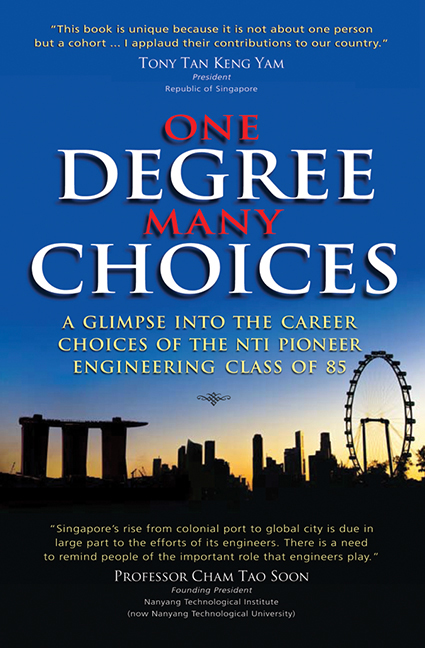 One Degree, Many Choices
One Degree, Many Choices Published online by Cambridge University Press: 21 October 2015
“My daughter Sarah is into her third year of the Mechanical Engineering programme at NTU.”
— Florence Tan Sok Bee, MPE PioneerIN DECEMBER 2010, THE CLASS OF 85, the pioneer batch of Nanyang Technological Institute (now known as Nanyang Technological University), celebrated the 25th anniversary of their graduation with a dinner. The question most frequently asked was “Hey, what happened to you all these years?” It was this question that sparked the idea of producing a book to capture our career paths.
The passage of 25 years yielded deep insights as we looked back on our engineering education. Most of us are about 50. Some of our children are already in campus. “My daughter Sarah is into her third year of the Mechanical Engineering programme at NTU. She is following in my footsteps,” declared Florence Tan Sok Bee proudly. It is time to ponder the next lap and prepare to hand the baton over to a younger generation of engineers.
Producing this book was exciting but far from easy. Tracking 557 pioneers was a challenge. Even when we did reach them, convincing them to share their life stories was no mean task. Some inspired ones contributed but others valued their privacy.
Credit goes to R. Sinnakaruppan, President of the NTU Alumni Club. A key mover behind the book, he sees the timeliness of this endeavour. A member of the board of several tertiary institutions, he is aware that engineering is no longer the degree of choice. Considering how Singapore's success is founded on the infrastructure laid by engineers including the NTI pioneers, the need to inspire future generations to take up engineering is a pressing matter. Engineers are crucial to any thriving economy.
Over the years, finance-related courses have replaced engineering as the course of choice. This seems inevitable given Singapore's status as a regional financial hub riding the Asia boom. Pragmatic young Singaporeans flock to where the money is, more so when the course is less demanding vis-à-vis engineering. The selection of university courses has become market-driven.
To save this book to your Kindle, first ensure [email protected] is added to your Approved Personal Document E-mail List under your Personal Document Settings on the Manage Your Content and Devices page of your Amazon account. Then enter the ‘name’ part of your Kindle email address below. Find out more about saving to your Kindle.
Note you can select to save to either the @free.kindle.com or @kindle.com variations. ‘@free.kindle.com’ emails are free but can only be saved to your device when it is connected to wi-fi. ‘@kindle.com’ emails can be delivered even when you are not connected to wi-fi, but note that service fees apply.
Find out more about the Kindle Personal Document Service.
To save content items to your account, please confirm that you agree to abide by our usage policies. If this is the first time you use this feature, you will be asked to authorise Cambridge Core to connect with your account. Find out more about saving content to Dropbox.
To save content items to your account, please confirm that you agree to abide by our usage policies. If this is the first time you use this feature, you will be asked to authorise Cambridge Core to connect with your account. Find out more about saving content to Google Drive.